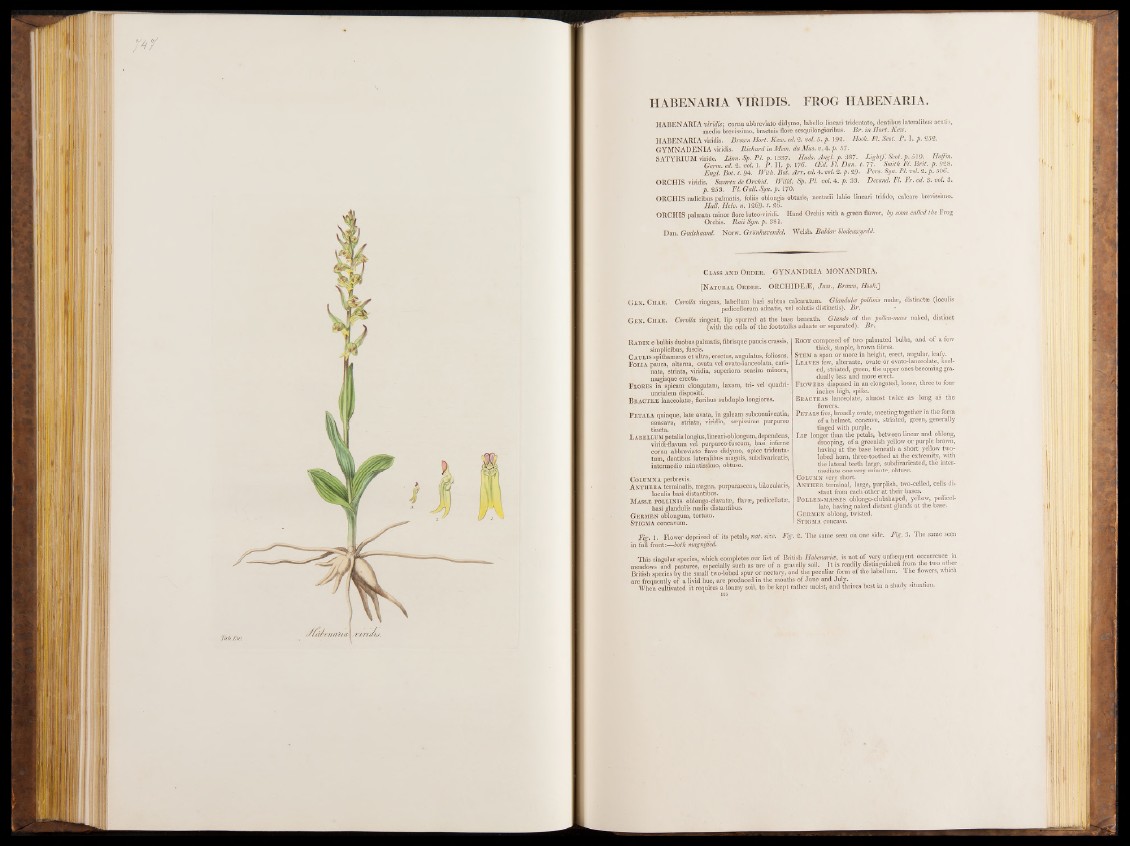
HABEN ARIA VIRIDIS. FROG HABENARIA.
HABENARIA viridis; cornu abbreviato didymo, labello line&ri tridentato, dentibus lateralibus acutis,
medio brevissimo, bracteis flore sesquilongioribus. B r . in H ort. Kew.
HABENARIA viridis. Brown Hort. Kew. ed. 2. vol. 5. p. 192. Hook. Fl. Scot. P . l . p . 252.
G YM N A D EN IA viridis. Richard in Mem. du Mus. v.4>. p. 57.
SATYRIUM viride. L im . Sp. P I. p. 1337. Httds. A n g l p. 387. Lig h t/. Scot. p. 519- Hofm.
Germ. ed. 2. vol. 1. P . I I. p. 176. (Ed. Fl. B a n . t. 77. Smith Fl. B rit. p. 928.
Engl. Bot. t. 94. With. Bot. A r r . ed. 4. vol. 2. p. 29. Pers. Syn. PI. vol. 2. p . 506.
O RCHIS viridis. Swartz de Orchid. Willd. Sp. P I. vol. 4. p. 33. Decand. Fl. Fr. ed. 3. vol. 3.
p. £53. Fl. Gail. Syn. p . 170.
ORCHIS radicibus palmatis, foliis oblongis obtusis, nectarii labio lineari trifido, calcare brevissimo.
Hall. Helv. n. 1269. t. 26.
O RCHIS palmata minor flore luteo-viridi. Hand Orchis with a green flower, by some called the Frog
Orchis. R aii Syn. p. 381.
Dan. Gudshaand. Norw. Griinhmendcl. Welsh. Baldar blodeuwyrdd.
Class a n d Order. G Y N A N D R IA M ONANDRIA.
[N atural Order. ORCHIDE.dE, Juss., Brown, Hook.]
Gen . Char. Corolla ringens, labellum basi subtus calcaratum. Glandultc pollinis nudte, distinct© (loculis
pedicellorum adnatis, vel solutis distinctis). B r .
Gen . Char. Corolla ringent, lip spurred at the base beneath. Glands of the pollen-mass naked, distinct
(with the cells of the footstalks adnate or separated). B r .
Ra dix e bulbis duobus palmatis, fibrisque paucis crassis,
' simplicibus, fuscis.
CaüLIS spithamæus et ultra, erectus, angulatus, foliosus.
Folia pauca, alterna, ovata vel ovato-lanceolata, carinata,
striata, viridia, superiora sensim minora,
magisque erecta.
Flores in spicam elongatam, laxam, tri- vel' quadri-
uncialem dispositi.
Bracteæ lanceolatoe, floribus subduplo longiores.
Petala quinque, late ovata, in galeam subconniventia,
concava, striata, viridia, sæpissime purpureo
tincta.
L abellum petalis longius,lineari-oblongum, dependens,
viridi-flavum vel purpureo-fuscum, basi inferne
cornu abbreviato flavo didymo, apice tridenta-
tum, dentibus lateralibus magnis, subdivaricatis,
intermèdio minutissimo, obtuso.
CoLUMNA perbrevis.
A ntiiera terminalis, magna, purpurascens, bilocularis,
loculis basi distantibus.
Massæ POLLINIS oblongo-clavatæ, flavæ, pedicellatæ,
basi glandulis nudis distantibus.
Germen oblongum, tortum.
Stigma concavum.
Root composed of two palmated bulbs, and of a few
thick, simple, brown fibres.
Stem a span or more in height, erect, angular, leafy.
Leaves few, alternate, ovate or ovato-lanceolate, keeled,
striated, green, the upper ones becoming gradually
less and more erect.
Flowers disposed in an elongated, loose, three to four
inches high, spike.
Bracteas lanceolate, almost twice as long as the
flowers.
Petals five, broadly ovate, meeting together in the form
of a helmet, concave, striated, green, generally
tinged with purple.
Lip longer than the petals, between linear and oblong,
drooping, of a greenish yellow or purple brown,
having at the base beneath a short yellow two-
lobed horn, three-toothed at the extremity, with
the lateral teeth large, subdivaricated, the intermediate
one very minute, obtuse.
Column very short.
Anther terminal, large, purplish, two-celled, cells distant
from each other at their bases.
Pollen-masses oblongo-clubshaped, yellow, pedicellate,
having naked distant glands at the base.
Germen oblong, twisted.
I Stigma concave.
Fig. 1. Flower deprived of its petals, m t . size. Fig. 2. The same seen on one side. Fig. 5. The same seen
in full front:— both magnified.
This singular species, which, completes our list of British Ilabetiariar, is not of very unfrequent occurrence in
meadows and pastures, especially such as are of a gravelly soil. I t is readily distinguished from the two other
British species by the small two-lobed spur or nectary, and the peculiar form of the labellum. lh e flowers, wnicn
are frequently of a livid hue, are produced in the months of June and July. ^ .
When cultivated it requires a loamy soil, to be kept rather moist, and thrives best m a shady situation.